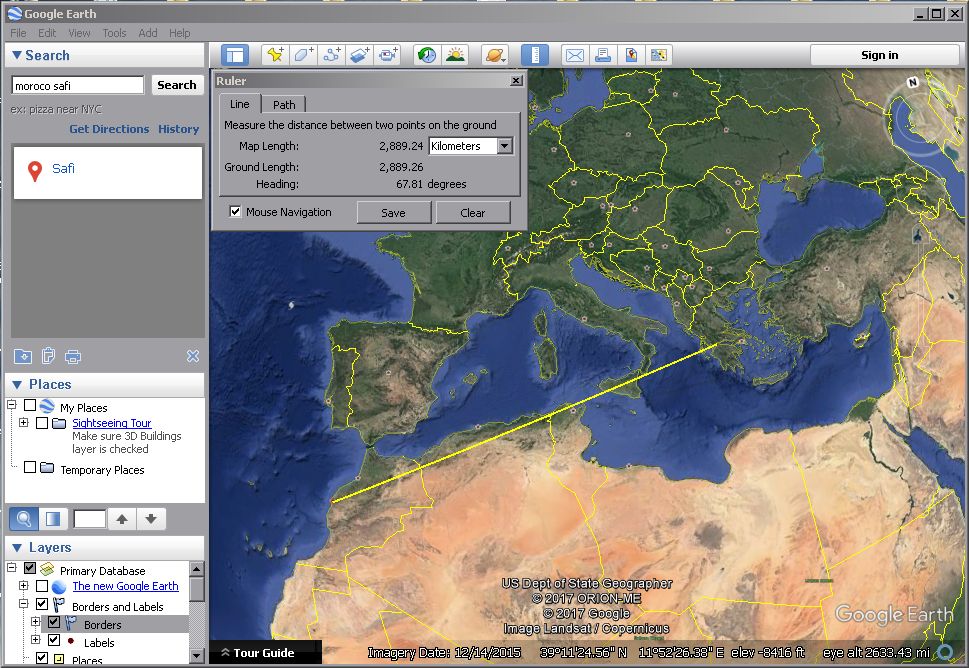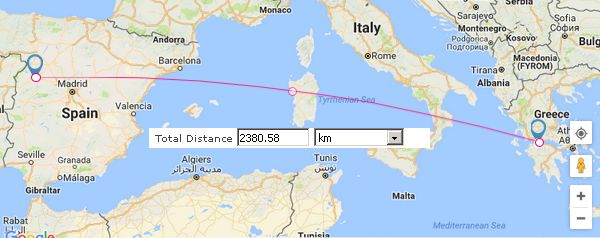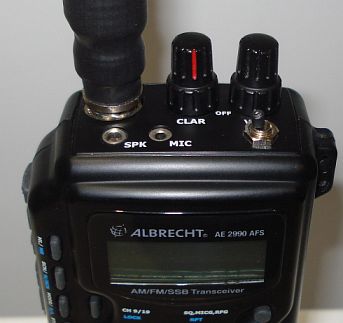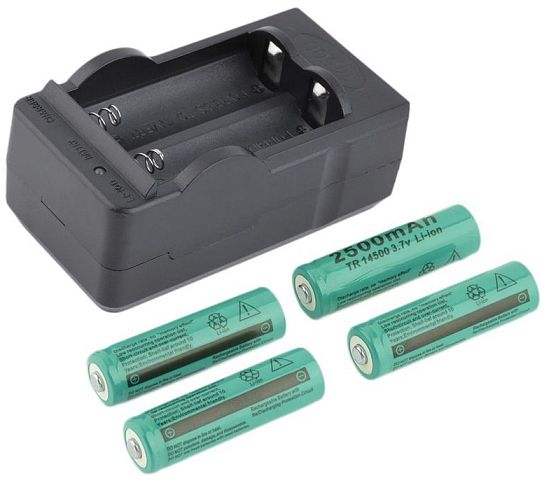Improving the Albrecht
AE2990AFS
by sv3ora
I like the 11 meters CB band. It is the most common band on shortwave where you can find many handheld transceivers. In Greece on 2017, the CB band became license free. Anyone can now get a CB radio and talk to other people. This allows both licensed radio amateurs and non-licensed citizens to talk together on shortwave. It is just like the PMR on 446MHz and the LPD on 433MHz but the CB is on shortwave instead, which has the advantage of covering thousands of kilometers if propagation conditions allow for it. No matter if the solar cycle is currently not forgiving for propagation and the band is closed, I have managed to make an SSB QSO on 10 meters (identical propagation characteristics with the 11m CB band) with the station CN3A, about 3.000Km away, from Greece to Morocco, at 28-10-2017. For this QSO, I have used the 1.5m telescopic antenna you see in the picture above and I got to the roof of a building, away from nearby obstacles. Below, my QSO is shown.

A second
QSO using exactly the same setup, has been done with the station TM5FI
located at Frioul Islands 1500Km away, on 28.495MHz at 10-5-2018, where
I got a 5-9 report. This QSO confirmed that long distance DX
communication using handheld transceivers and antennas on the higher HF
bands, can be acomplished when propagation conditions are right.
A third
QSO (below) confirmed this once more. The QSO was with EB1CRW from
Spain about 2400km away, at 28.499MHz on 13-5-2018 21:30, giving a 5/5 report.

Almost all of the handheld CB transceivers operate on AM or/and FM modulations. However, there are very few exceptions to this. One of these, is the Albrecht AE2990AFS radio shown in this page (user manual here, service manual here, technical specs from the Magnum 1012 which is identical inside here), which can operate on AM/FM/USB/LSB. It can also be very easily modified to cover the amateur radio bands of 10 meter and 12 meter (the radio resets itself after switching from CB to HAM bands), so if you are a licensed radio amateur you can use it in these bands as well. Note that some of the other handheld CB transceivers can be also modified to have more channels (which are in the 10 meter band usually) but this transceiver has continuous coverage on 10 and 12 meter bands, i.e. frequencies and not just channels.
No matter of these advantages, it has shortcomings, like ghost signals generated by the radio and appear in-band, and a not so helpful scanning mechanism. It is also quite big and heavy compared to the UHF radios, but this is the case with all other CB handhelds I have come across. Apart from these shortcomings and because of the much lower frequency, you cannot avoid the much larger CB antennas if you are interested in DX communications. However, for local contacts of a few km away, the standard rubber duck antenna that comes with the radio, is ok.
In handheld transceivers, weight and more importantly size, does matter indeed. So I felt that I could improve the radio a bit in this aspect, but also improving the rest of the capabilities a bit. This page explains my modifications to the radio.
The picture below, shows my radio as I have bought it second hand. It was in a like-new condition, not even a single scratch and fully operational. The seller sent me additionally a leather case as well as a big telescopic antenna for the radio. These telescopic antennas and cases can be bought online cheaply. The radio came with the coverage modification already present, so I did not have to do it myself. Here is the modification if you want to do it yourself. The seller has included a switch at the top of the radio, so it can be switched instantly between different coverage ranges, without the need to open the radio every time, very convenient.
The radio is quite big, just like any modern CB handheld. The first thing I did to reduce it's size, was to remove the back belt clip as shown in the picture below. I really do not feel comfortable in carrying on my belt such a heavy and big transceiver, so removing this clip did not bother me.
The next thing, was to remove the hand strip from the radio as shown in the picture below. It may be usable sometimes though to have this strip in place so as to prevent the radio from dropping off your hands, but I am quite careful and I do not mind removing it.
Next, I
cut the band changing switch (modification) that has been instaled by
the previous owner, so as to make it of lower profile. I also used a
small piece of thermal shrink tube to cover it so as to make it black
as shown in the next picture.

Next, I have decided to do something about the big and bulky battery pack. The battery pack, filled with 9 Ni-MH batteries, weights more than the radio and is has almost the same size as the radio alone. I have discovered that the auxiliary alkaline battery pack of a Midland Alan 42 CB radio I had, fitted almost perfectly the Albrecht radio. In the picture below, this modification is shown. There is only about 2mm of space left, at the right hand side of the radio near the battery pack edge, which is not very annoying, having in mind that the radio total height is reduced to something like 70-80% with this simple trick.
However, this modification allows only 6 Ni-MH batteries to power the radio and the total voltage is only about 7.2v. This is too low and the radio can only switched on to receiver mode. Any attempt to PTT and the battery symbol in the LCD of the radio gets empty and flashing.
To overcome the problem of low voltage, but also to keep the small size, I decided to switch to alternative batteries. The batteries I purchased were 2500mAh, TR14500 type, 3.7V Rechargeable Li-ion. These have exactly the same size as the Ni-MH types so they fit directly into the battery pack. The ones I purchased, have almost the same capacity as the Ni-MH types I have previously used. I had to purchase their charger as well, as the standard Ni-MH charger cannot charge these. Both the charger and the batteries are very cheap and they usually weight less than the Ni-MH types. The advantage is that you only need 3 of these batteries to power the radio, as each battery is capable of providing 3.7v. With 3 batteries the total voltage is 11.1v, which is very close to the nominal voltage of the radio. The rest of the unused battery places inside the battery pack can be short circuited with a piece of cable, but I wouldn't solder the cable to the battery terminals, I would just wrap it around them. I bought 4 of these Li-ion batteries, to test if the radio would operate ok at 14.8v as well. If so, this could possibly give more RF output power, but it may make the radio hot.
I am still waiting for the batteries to arrive to test them.

The picture below shows the different antennas I have tried with the radio. These are all CB (11m) antennas. From the left to the right: The transceiver, the original antenna that comes with the radio, the Midland Alan 42 original antenna, a cheap Asian rubber duck I bought online, a better quality US-made rubber duck (not so flexible) that has a screw under the top cap for precise tuning, the 1.4m telescopic whip antenna I have used on my long range QSO.
Because the longer antenna the better on CB, the telescopic whip outer performs the rest of the antennas. After all, when fully extended, this antenna is close to L/8 for the CB band. I have added an additional 10cm element on this whip antenna, from another antenna I already had, to make it about 1.5m long. Despite this, when the whip is closed, it is almost the same size as the two other rubber duck antennas, so it is quite compact when transporting.
With such a long antenna, even the slightest weight at the opposite end of its connector will harass the connector of the radio. For that reason, I cut the end eye-protective metal part of the last antenna element and I fitted in place a small piece of thermal shrink tube for eye protection instead, which is lighter. This can be seen in the picture below. Also, with such a long antenna you may find it more difficult to hold the radio in your palm when the antenna is fully extended and when the air blows. No matter if the antenna has a steel spring near the connector to absorb the wind or hand vibrations (which is used also as a loading coil), you have to be a bit careful not to ruin the radio connector from excessive vibrations. Just be gentle when moving around and operating the radio with the antenna fully extended and you will be fine.
To be continued...